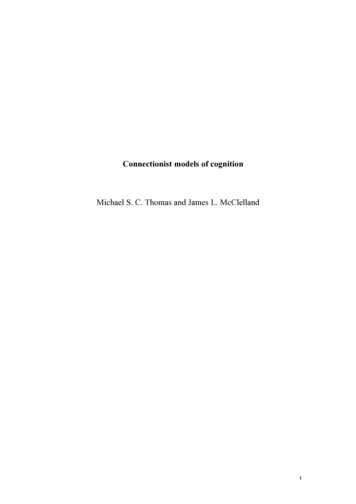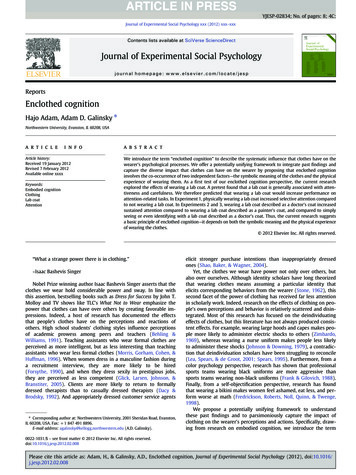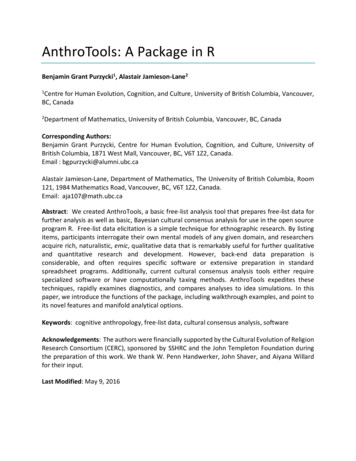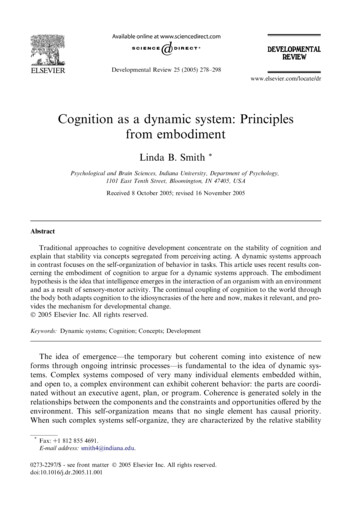
Transcription
Connectionist models of cognitionMichael S. C. Thomas and James L. McClelland1
1. IntroductionIn this chapter, we review computer models of cognition that have focused on the useof neural networks. These architectures were inspired by research into howcomputation works in the brain and subsequent work has produced models ofcognition with a distinctive flavor. Processing is characterized by patterns ofactivation across simple processing units connected together into complex networks.Knowledge is stored in the strength of the connections between units. It is for thisreason that this approach to understanding cognition has gained the name ofconnectionism.2. BackgroundOver the last twenty years, connectionist modeling has formed an influential approachto the computational study of cognition. It is distinguished by its appeal to principlesof neural computation to inspire the primitives that are included in its cognitive levelmodels. Also known as artificial neural network (ANN) or parallel distributedprocessing (PDP) models, connectionism has been applied to a diverse range ofcognitive abilities, including models of memory, attention, perception, action,language, concept formation, and reasoning (see, e.g., Houghton, 2005). While manyof these models seek to capture adult function, connectionism places an emphasis onlearning internal representations. This has led to an increasing focus on developmentalphenomena and the origins of knowledge. Although, at its heart, connectionismcomprises a set of computational formalisms, it has spurred vigorous theoreticaldebate regarding the nature of cognition. Some theorists have reacted by dismissingconnectionism as mere implementation of pre-existing verbal theories of cognition,while others have viewed it as a candidate to replace the Classical Computational2
Theory of Mind and as carrying profound implications for the way human knowledgeis acquired and represented; still others have viewed connectionism as a sub-class ofstatistical models involved in universal function approximation and data clustering.In this chapter, we begin by placing connectionism in its historical context,leading up to its formalization in Rumelhart and McClelland’s two-volume ParallelDistributed Processing (1986) written in combination with members of the ParallelDistributed Processing Research Group. We then discuss three important early modelsthat illustrate some of the key properties of connectionist systems and indicate howthe novel theoretical contributions of these models arose from their key computationalproperties. These three models are the Interactive Activation model of letterrecognition (McClelland & Rumelhart, 1981; Rumelhart and McClelland, 1982),Rumelhart and McClelland’s model of the acquisition of the English past tense(1986), and Elman’s simple recurrent network for finding structure in time (1991).We finish by considering how twenty-five years of connectionist modeling hasinfluenced wider theories of cognition.2.1 Historical contextConnectionist models draw inspiration from the notion that the informationprocessing properties of neural systems should influence our theories of cognition.The possible role of neurons in generating the mind was first considered not long afterthe existence of the nerve cell was accepted in the latter half of the 19th Century(Aizawa, 2004). Early neural network theorizing can therefore be found in some ofthe associationist theories of mental processes prevalent at the time (e.g., Freud, 1895;James, 1890; Meynert, 1884; Spencer, 1872). However, this line of theorizing wasquelled when Lashley presented data appearing to show that the performance of the3
brain degraded gracefully depending only on the quantity of damage. This arguedagainst the specific involvement of neurons in particular cognitive processes (see,e.g., Lashley, 1929).In the 1930s and 40s, there was a resurgence of interest in using mathematicaltechniques to characterize the behavior of networks of nerve cells (e.g., Rashevksy,1935). This culminated in the work of McCulloch and Pitts (1943) who characterizedthe function of simple networks of binary threshold neurons in terms of logicaloperations. In his 1949 book The Organization of Behavior, Donald Hebb proposed acell assembly theory of cognition, including the idea that specific synaptic changesmight underlie psychological principles of learning. A decade later, Rosenblatt (1958,1962) formulated a learning rule for two-layered neural networks, demonstratingmathematically that the perceptron convergence rule could adjust the weightsconnecting an input layer and an output layer of simple neurons to allow the networkto associate arbitrary binary patterns. With this rule, learning converged on the set ofconnection values necessary to acquire any two-layer-computable function relating aset of input-output patterns. Unfortunately, Minsky and Papert (1969) demonstratedthat the set of two-layer computable functions was somewhat limited – that is, thesesimple artificial neural networks were not particularly powerful devices. While morecomputationally powerful networks could be described, there was no algorithm tolearn the connection weights of these systems. Such networks required the postulationof additional internal or ‘hidden’ processing units, which could adopt intermediaterepresentational states in the mapping between input and output patterns. Analgorithm (backpropagation) able to learn these states was discovered independentlyseveral times. A key paper by Rumelhart, Hinton and Williams (1986) demonstrated4
the usefulness of networks trained using backpropagation for addressing keycomputational and cognitive challenges facing neural networks.In the 1970s, serial processing and the Von Neumann computer metaphordominated cognitive psychology. Nevertheless, a number of researchers continued towork on the computational properties of neural systems. Some of the key themesidentified by these researchers include the role of competition in processing andlearning (e.g., Grossberg, 1976; Kohonen, 1984), the properties of distributedrepresentations (e.g., Anderson, 1977; Hinton & Anderson, 1981), and the possibilityof content addressable memory in networks with attractor states, formalized using themathematics of statistical physics (Hopfield, 1982). A fuller characterization of themany historical influences in the development of connectionism can be found inRumelhart and McClelland (1986, chapter 1), Bechtel and Abrahamsen (1991),McLeod, Plunkett, and Rolls (1998), and O’Reilly and Munakata (2000). Figure 1depicts a selective schematic of this history and demonstrates the multiple types ofneural network system that have latterly come to be used in building models ofcognition. While diverse, they are unified on the one hand by the proposal thatcognition comprises processes of constraint satisfaction, energy minimization andpattern recognition, and on the other that adaptive processes construct themicrostructure of these systems, primarily by adjusting the strengths of connectionsamong the neuron-like processing units involved in a computation.-------------------------------Insert Figure 1 about here--------------------------------2.2 Key properties of connectionist models5
Connectionism starts with the following inspiration from neural systems:computations will be carried out by a set of simple processing units operating inparallel and affecting each others’ activation states via a network of weightedconnections. Rumelhart, Hinton and McClelland (1986) identified seven key featuresthat would define a general framework for connectionist processing.The first feature is the set of processing units ui. In a cognitive model, thesemay be intended to represent individual concepts (such as letters or words), or theymay simply be abstract elements over which meaningful patterns can be defined.Processing units are often distinguished into input, output, and hidden units. Inassociative networks, input and output units have states that are defined by the taskbeing modeled (at least during training), while hidden units are free parameters whosestates may be determined as necessary by the learning algorithm.The second feature is a state of activation (a) at a given time (t). The state of aset of units is usually represented by a vector of real numbers a(t). These may bebinary or continuous numbers, bounded or unbounded. A frequent assumption is thatthe activation level of simple processing units will vary continuously between thevalues 0 and 1.The third feature is a pattern of connectivity. The strength of the connectionbetween any two units will determine the extent to which the activation state of oneunit can affect the activation state of another unit at a subsequent time point. Thestrength of the connections between unit i and unit j can be represented by a matrix Wof weight values wij. Multiple matrices may be specified for a given network if thereare connections of different types. For example, one matrix may specify excitatoryconnections between units and a second may specify inhibitory connections.Potentially, the weight matrix allows every unit to be connected to every other unit in6
the network. Typically, units are arranged into layers (e.g., input, hidden, output) andlayers of units are fully connected to each other. For example, in a three-layerfeedforward architecture where activation passes in a single direction from input tooutput, the input layer would be fully connected to the hidden layer and the hiddenlayer would be fully connected to the output layer.The fourth feature is a rule for propagating activation states throughout thenetwork. This rule takes the vector a(t) of output values for the processing unitssending activation and combines it with the connectivity matrix W to produce asummed or net input into each receiving unit. The net input to a receiving unit isproduced by multiplying the vector and matrix together, so thatneti W " a(t ) ! wij a j(1)jThe fifth feature is an activation rule to specify how the net inputs to a given unit arecombined to produce its new activation state. The function F derives the newactivation stateai (t 1) F (neti (t ))(2)For example, F might be a threshold so that the unit becomes active only if the netinput exceeds a given value. Other possibilities include linear, Gaussian, and sigmoidfunctions, depending on the network type. Sigmoid is perhaps the most common,operating as a smoothed threshold function that is also differentiable. It is oftenimportant that the activation function be differentiable because learning seeks toimprove a performance metric that is assessed via the activation state while learningitself can only operate on the connection weights. The effect of weight changes on theperformance metric therefore depends to some extent on the activation function, andthe learning algorithm encodes this fact by including the derivative of that function(see below).7
The sixth key feature of connectionist models is the algorithm for modifyingthe patterns of connectivity as a function of experience. Virtually all learning rules forPDP models can be considered a variant of the Hebbian learning rule (Hebb, 1949).The essential idea is that a weight between two units should be altered in proportionto the units’ correlated activity. For example, if a unit ui receives input from anotherunit uj, then if both are highly active, the weight wij from uj to ui should bestrengthened. In its simplest version, the rule is"wij ! ai a j(3)where η is the constant of proportionality known as the learning rate. Where anexternal target activation ti(t) is available for a unit i at time t, this algorithm ismodified by replacing ai with a term depicting the disparity of unit ui’s currentactivation state ai(t) from its desired activation state ti(t) at time t, so forming the deltarule:"wij # (ti (t )! ai (t )) a j(4)However, when hidden units are included in networks, no target activation is availablefor these internal parameters. The weights to such units may be modified by variantsof the Hebbian learning algorithm (e.g., Contrastive Hebbian; Hinton, 1989; see Xie& Seung, 2003) or by the backpropagation of error signals from the output layer.Backpropagation makes it possible to determine, for each connection weightin the network, what effect a change in its value would have on the overall networkerror. The policy for changing the strengths of connections is simply to adjust eachweight in the direction (up or down) that would tend to reduce the error, by an amountproportional to the size of the effect the adjustment will have. If there are multiplelayers of hidden units remote from the output layer, this process can be followediteratively: first error derivatives are computed for the hidden layer nearest the output8
layer; from these, derivatives are computed for the next deepest layer into thenetwork, and so forth. On this basis, the backpropagation algorithm serves to modifythe pattern of weights in powerful multilayer networks. It alters the weights to eachdeeper layer of units in such a way as to reduce the error on the output units (seeRumelhart, Hinton, & Williams, 1986, for the derivation). We can formulate theweight change algorithm by analogy to the delta rule in shown in equation 4. For eachdeeper layer in the network, we modify the central term that represents the disparitybetween the actual and target activation of the units. Assuming ui, uh, and uo are input,hidden, and output units in a 3-layer feedforward network, the algorithm for changingthe weight from hidden to output unit is:"woh # (to ! ao )F ' (neto ) ah(5)where F ' (net ) is the derivative of the activation function of the units (e.g., for thesigmoid activation function, F ' (neto ) ao (1 ! ao )). The term (to – ao) is proportional tothe negative of the partial derivative of the network’s overall error with respect to the2activation of the output unit, where the error E is given by E ! (to " ao ) .oThe derived error term for a unit at the hidden layer is based on the derivativeof the hidden unit’s activation function, times the sum across all the connections fromthat hidden unit to the output later of the error term on each output unit weighted bythe derivative of the output unit’s activation function (to ! ao )F ' (neto ) times theweight connecting the hidden unit to the output unit:F ' (net h )!o (t o " a o )F ' (net o ) woh(6)The algorithm for changing the weights from the input to the hidden layer is therefore:#whi F ' (net h ) !o (t o " a o )F ' (net o ) woh ai(7)9
It is interesting that the above computation can be construed as a backward passthrough the network, similar in spirit to the forward pass that computes activations inthat it involves propagation of signals across weighted connections, this time from theoutput layer back toward the input. The backward pass, however, involves thepropagation of error derivatives rather than activations.It should be emphasized that a very wide range of variants and extensions ofHebbian and error-correcting algorithms have been introduced in the connectionistlearning literature. Most importantly, several variants of backpropagation have beendeveloped for training recurrent networks (Williams & Zipser, 1995); and severalalgorithms (including the Contrastive Hebbian Learning algorithm and O’Reilly’s1998 LEABRA algorithm) have addressed some of the concerns that have been raisedregarding the biological plausibility of backpropagation construed in its most literalform (O’Reilly & Munakata, 2000).The last general feature of connectionist networks is a representation of theenvironment with respect to the system. This is assumed to consist of a set ofexternally provided events or a function for generating such events. An event may bea single pattern, such as a visual input; an ensemble of related patterns, such as thespelling of a word and its corresponding sound and/or meaning; or a sequence ofinputs, such as the words in a sentence. A range of policies have been used forspecifying the order of presentation of the patterns, including sweeping through thefull set to random sampling with replacement. The selection of patterns to presentmay vary over the course of training but is often fixed. Where a target output is linkedto each input, this is usually assumed to be simultaneously available. Two points areof note in the translation between PDP network and cognitive model. First, arepresentational scheme must be defined to map between the cognitive domain of10
interest and a set of vectors depicting the relevant informational states or mappingsfor that domain. Second, in many cases, connectionist models are addressed to aspectsof higher-level cognition, where it is assumed that the information of relevance ismore abstract than sensory or motor codes. This has meant that the models often leaveout details of the transduction of sensory and motor signals, using input and outputrepresentations that are already somewhat abstract. We hold the view that the sameprinciples at work in higher-level cognition are also at work in perceptual and motorsystems, and indeed there is also considerable connectionist work addressing issues ofperception and action, though these will not be the focus of the present article.2.3 Neural plausibilityIt is a historical fact that most connectionist modelers have drawn their inspirationfrom the computational properties of neural systems. However, it has become a pointof controversy whether these ‘brain-like’ systems are indeed neurally plausible. Ifthey are not, should they instead be viewed as a class of statistical functionalapproximators? And if so, shouldn’t the ability of these models to simulate patterns ofhuman behavior be assessed in the context of the large number of free parameters theycontain (e.g., in the weight matrix) (Green, 1998)?Neural plausibility should not be the primary focus for a consideration ofconnectionism. The advantage of connectionism, according to its proponents, is that itprovides better theories of cognition. Nevertheless, we will deal briefly with this issuesince it pertains to the origins of connectionist cognitive theory. In this area, two sortsof criticism have been leveled at connectionist models. The first is to maintain thatmany connectionist models either include properties that are not neurally plausibleand/or omit other properties that neural systems appear to have. Some connectionist11
researchers have responded to this first criticism by endeavoring to show how featuresof connectionist systems might in fact be realized in the neural machinery of thebrain. For example, the backward propagation of error across the same connectionsthat carry activation signals is generally viewed as biologically implausible. However,a number of authors have shown that the difference between activations computedusing standard feedforward connections and those computed using standard returnconnections can be used to derive the crucial error derivatives required bybackpropagation (Hinton & McClelland, 1988; O’Reilly, 1996). It is widely held thatconnections run bi-directionally in the brain, as required for this scheme to work.Under this view, backpropagation may be shorthand for a Hebbian-based algorithmthat uses bi-directional connections to spread error signals throughout a network (Xie& Seung, 2003).Other connectionist researchers have responded to the first criticism bystressing the cognitive nature of current connectionist models. Most of the work indevelopmental neuroscience addresses behavior at levels no higher than cellular andlocal networks, whereas cognitive models must make contact with the humanbehavior studied in psychology. Some simplification is therefore warranted, withneural plausibility compromised under the working assumption that the simplifiedmodels share the same flavor of computation as actual neural systems. Connectionistmodels have succeeding in stimulating a great deal of progress in cognitive theory –and sometimes generating radically different proposals to the previously prevailingsymbolic theory – just given the set of basic computational features outlined in thepreceding section.The second type of criticism leveled at connectionism questions why, asDavies (2005) puts it, connectionist models should be reckoned any more plausible as12
putative descriptions of cognitive processes just because they are ‘brain-like’. Underthis view, there is independence between levels of description because a givencognitive level theory might be implemented in multiple ways in different hardware.Therefore the details of the hardware (in this case, the brain) need not concern thecognitive theory. This functionalist approach, most clearly stated in Marr’s threelevels of description (computational, algorithmic, and implementational; see Marr,1982) has been repeatedly challenged (see, e.g., Rumelhart & McClelland, 1985;Mareschal et al., 2007). The challenge to Marr goes as follows. While, according tocomputational theory, there may be a principled independence between a computerprogram and the particular substrate on which it is implemented, in practical terms,different sorts of computation are easier or harder to implement on a given substrate.Since computations have to be delivered in real time as the individual reacts with hisor her environment, in the first instance cognitive level theories should be constrainedby the computational primitives that are most easily implemented on the availablehardware; human cognition should be shaped by the processes that work best in thebrain.The relation of connectionist models to symbolic models has also provedcontroversial. A full consideration of this issue is beyond the scope of the currentchapter. Suffice to say that because the connectionist approach now includes a diversefamily of models, there is no single answer to this question. Smolensky (1988) arguedthat connectionist models exist at a lower (but still cognitive) level of description thansymbolic cognitive theories, a level that he called the sub-symbolic. Connectionistmodels have sometimes been put forward as a way to implement symbolic productionsystems on neural architectures (e.g., Touretzky & Hinton, 1988). At other times,connectionist researchers have argued that their models represent a qualitatively13
different form of computation: while under certain circumstances, connectionistmodels might produce behavior approximating symbolic processes, it is held thathuman behavior, too, only approximates the characteristics of symbolic systems ratherthan directly implementing them. Furthermore, connectionist systems incorporateadditional properties characteristic of human cognition, such as content addressablememory, context-sensitive processing, and graceful degradation under damage ornoise. Under this view, symbolic theories are approximate descriptions rather thanactual characterizations of human cognition. Connectionist theories should replacethem because they both capture subtle differences between human behavior andsymbolic characterizations, and because they provide a specification of the underlyingcausal mechanisms (van Gelder, 1991).This strong position has prompted criticisms that in their current form,connectionist models are insufficiently powerful to account for certain aspects ofhuman cognition – in particular those areas best characterized by symbolic,syntactically driven computations (Fodor & Pylyshyn, 1988; Marcus, 2001). Again,however, the characterization of human cognition in such terms is highlycontroversial; close scrutiny of relevant aspects of language – the ground on whichthe dispute has largely been focused – lends support to the view that the systematicityassumed by proponents of symbolic approaches is overstated, and that the actualcharacteristics of language are well matched to the characteristics of connectionistsystems (Bybee & McClelland, 2005; McClelland, Plaut, Gotts & Maia, 2003). In theend, it may be difficult to make principled distinctions between symbolic andconnectionist models. At a fine scale, one might argue that two units in a networkrepresent variables and the connection between them specifies a symbolic rule linkingthese variables. One might also argue that a production system in which rules are14
allowed to fire probabilistically and in parallel begins to approximate a connectionistsystem.2.4 The relationship between connectionist models and Bayesian inferenceSince the early 1980s, it has been apparent that there are strong links between thecalculations carried out in connectionist models and key elements of Bayesiancalculations. The state of the early literature on this point was reviewed in McClelland(1998). There it was noted, first of all, that units can be viewed as playing the role ofprobabilistic hypotheses; that weights and biases play the role of conditionalprobability relations between hypotheses and prior probabilities, respectively; and thatif connection weights and biases have the correct values, the logistic activationfunction sets the activation of a unit to its posterior probability given the evidencerepresented on its inputs. A second and more important observation is that, instochastic neural networks (Boltzmann Machines and Continuous DiffusionNetworks; Hinton & Sejnowski, 1986; Movellan & McClelland, 1993) a network’sstate over all of its units can represent a constellation of hypotheses about an input;and (if the weights and the biases are set correctly) that the probability of finding thenetwork in a particular state is monotonically related to the probability that the state isthe correct interpretation of the input. The exact nature of the relation depends on aparameter called temperature; if set to one, the probability that the network will befound in a particular state exactly matches its posterior probability. When temperatureis gradually reduced to zero, the network will end up in the most probable state, thusperforming optimal perceptual inference (Hinton & Sejnowski, 1983). It is alsoknown that backpropagation can learn weights that allow Bayes-optimal estimation ofoutputs given inputs (MacKay, 1993) and that the Boltzmann machine learning15
algorithm (Ackley, Hinton, & Sejnowski, 1986; Movellan & McClelland, 1993) canlearn to produce correct conditional distributions of outputs given inputs. Thealgorithm is slow but there has been recent progress producing substantial speedupsthat achieve outstanding performance on benchmark data sets (Hinton &Salakhutdinov, 2006).16
3. Three illustrative modelsIn this section, we outline three of the landmark models in the emergence ofconnectionist theories of cognition. The models serve to illustrate the key principlesof connectionism and demonstrate how these principles are relevant to explainingbehavior in ways that are different from other prior approaches. The contribution ofthese models was twofold: they were better suited than alternative approaches tocapturing the actual characteristics of human cognition, usually on the basis of theircontext sensitive processing properties; and compared to existing accounts, theyoffered a sharper set of tools to drive theoretical progress and to stimulate empiricaldata collection. Each of these models significantly advanced its field.3.1 An interactive activation model of context effects in letter perception(McClelland & Rumelhart, 1981, 1982)The interactive activation model of letter perception illustrates two interrelated ideas.The first is that connectionist models naturally capture a graded constraint satisfactionprocess in which the influences of many different types of information aresimultaneously integrated in determining, for example, the identity of a letter in aword. The second idea is that the computation of a perceptual representation of thecurrent input (in this case, a word) involves the simultaneous and mutual influence ofrepresentations at multiple levels of abstraction – this is a core idea of paralleldistributed processing.The interactive activation model addressed itself to a puzzle in wordrecognition. By the late 1970s, it had long been known that people were better atrecognizing letters presented in words than letters presented in random lettersequences. Reicher (1969) demonstrated that this was not the result of tending to17
guess letters that would make letter strings into words. He presented target letterseither in words, unpronounceable nonwords, or on their own. The stimuli were thenfollowed by a pattern mask, after which participants were presented with a forcedchoice between two letters in a given position. Importantly, both alternatives wereequally plausible. Thus, the participant might be presented with WOOD and askedwhether the third letter was O or R. As expected, forced-choice performance wasmore accurate for letters in words than for letters in nonwords or presented on theirown. Moreover, the benefit of surrounding context was also conferred bypronounceable pseudowords (e.g., recognizing the P in SPET) compared to randomletter strings, suggesting that subjects were able to bring to bear rules regarding theorthographic legality of letter strings during recognition.Rumelhart and McClelland took the contextual advantage of words andpseudowords on letter recognition to indicate the operation of top-down processing.Previous theories had put forward the idea that letter and word recognition might beconstrued in terms of detectors which collect evidence consistent with the presence oftheir assigned letter or word in the input (Morton, 1969; Selfridge, 1959). Influencedby these theories, Rumelhart and McClelland built a computational simulation inwhich the perception of letters resulted from excitatory and inhibitory interactions ofdetectors for visual features. Importantly, the detectors were organized
Theory of Mind and as carrying profound implications for the way human knowledge . connecting an input layer and an output layer of simple neurons to allow the network . dominated cognitive psychology










